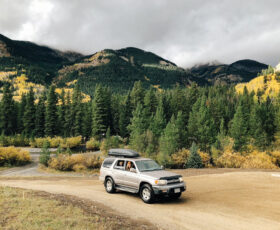Last Updated on 4 months
When and Why to Switching from All-Season to Winter Tires
For decades, the winter vs. all-season tires debate has been one of the most common topics amongst drivers when the temperatures get nearly freezing. Although all-season tires are popular and commonly included as OEM equipment, they cannot handle harsh winters (deep snow and ice). They can handle mild winter conditions (think light snow, rain, and slush). Demanding conditions require proper winter tires to perform their best and keep your passengers safe. That is why many all-season users switch to winter tires at the end of the year.
If you plan to switch, we will explore transitioning from all-season to winter tires and why this change is crucial for winter driving.
Why You Should Switch To Winter Tires
Improved Traction and Safety in Snow and Ice
Winter tires have deeper tread patterns and specialized rubber compounds that remain flexible in cold weather. This feature allows them to grip snow and ice more effectively than all-season tires, significantly reducing the risk of skidding or losing control. With winter tires, braking distances on icy roads can be shortened by up to 25%, significantly increasing your safety.
Optimized Performance in Cold Weather
All-season tires lose grip and elasticity when temperatures drop below 45°F (7°C). Winter tires, however, are made of softer rubber compounds that stay pliable even in freezing conditions. This flexibility ensures better contact with the road, enhancing traction and overall handling.
Compliance with Local Regulations
Winter tires are mandatory during the colder months in certain regions, such as Canada and parts of Europe. Failure to switch to winter tires can result in fines, invalid insurance claims, or being turned away from certain roads. Even if you don’t live in an area with winter tire laws, the safety benefits make the switch worthwhile.
Prolonging Tire Lifespan
Switching to winter tires during the cold months gives your all-season or summer tires a break, extending their lifespan. Using dedicated winter tires for their intended season can help you avoid premature wear on your all-season tires and ensure better overall tire performance year-round.
What To Know When Switching To Winter Tires
There is no difference in overall look or price compared to all-season or summer tires, but there are a few things you should be aware of. First of all, do you need standard winter tires or studded winter tires? Standard winter tires are quieter and provide excellent traction in snowy conditions, making them a good choice for areas with mixed winter weather.
However, the studded option is better for frigid climates with lots of snow and ice. Studded tires have small rubber studs on the tread blocks that pierce through the snow or ice, keeping contact with the asphalt. Before purchasing the studded tires, check your local laws and regulations since legislation differs from state to state. One of the best tires in this category is the Nokian Hakkapeliitta 10.
What Is The Difference Between All-Season And Winter Tires
Tread Pattern:
Winter tires feature deeper and more aggressive tread patterns with more significant gaps between tread blocks, which help channel snow, slush, and water away, reducing the risk of hydroplaning. All-season tires have a shallower, balanced tread designed for various road conditions but may struggle in deep snow or ice.
Special Rubber Compound:
Winter tires use a softer rubber compound that stays flexible in cold weather, improving grip on snow and ice. By contrast, all-season tires harden in freezing temperatures, reducing their effectiveness in winter conditions.
Sipes:
Winter tires have a higher number of sipes, which are tiny slits in the tread that increase the tire’s ability to grip the road, especially on ice. All-season tires typically have fewer sipes, making them less effective in extreme winter conditions.
Conclusion
Switching from all-season to winter tires is a smart choice for anyone driving in cold, snowy, or icy conditions. Winter tires are specifically designed to provide superior traction, safety, and overall performance, making them an essential investment for your vehicle. By applying the tips outlined in this guide, you can make a smooth transition to winter tires and be confident that you’ll be able to face any winter challenges. If you are unsure which winter tire to get, check out our reviews, like this one, for helpful recommendations.










